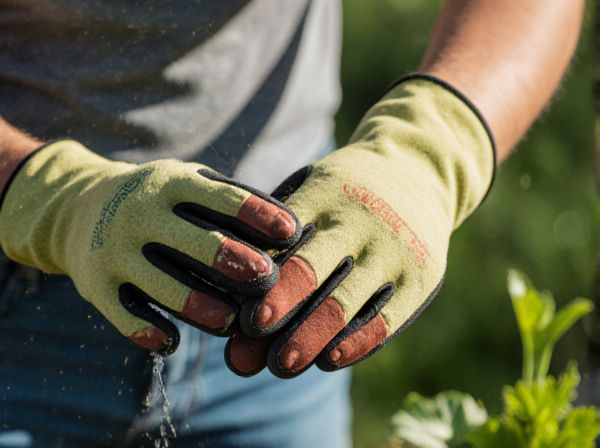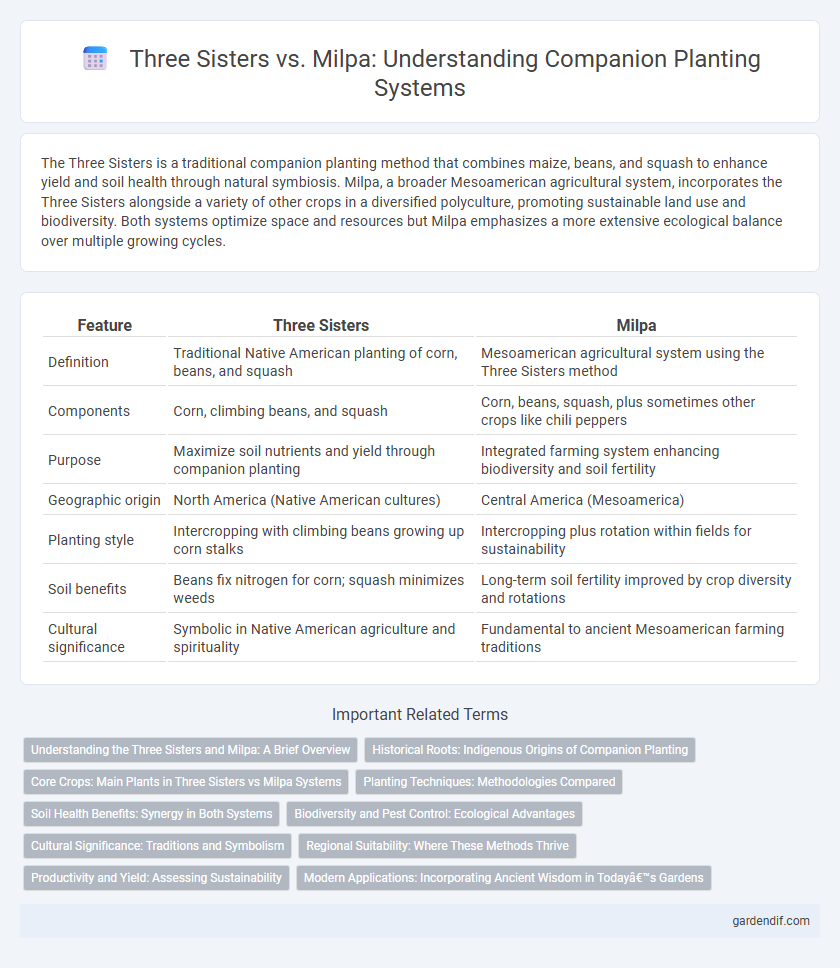
Three Sisters vs Milpa Illustration
The Three Sisters is a traditional companion planting method that combines maize, beans, and squash to enhance yield and soil health through natural symbiosis. Milpa, a broader Mesoamerican agricultural system, incorporates the Three Sisters alongside a variety of other crops in a diversified polyculture, promoting sustainable land use and biodiversity. Both systems optimize space and resources but Milpa emphasizes a more extensive ecological balance over multiple growing cycles.
Table of Comparison
| Feature | Three Sisters | Milpa |
|---|---|---|
| Definition | Traditional Native American planting of corn, beans, and squash | Mesoamerican agricultural system using the Three Sisters method |
| Components | Corn, climbing beans, and squash | Corn, beans, squash, plus sometimes other crops like chili peppers |
| Purpose | Maximize soil nutrients and yield through companion planting | Integrated farming system enhancing biodiversity and soil fertility |
| Geographic origin | North America (Native American cultures) | Central America (Mesoamerica) |
| Planting style | Intercropping with climbing beans growing up corn stalks | Intercropping plus rotation within fields for sustainability |
| Soil benefits | Beans fix nitrogen for corn; squash minimizes weeds | Long-term soil fertility improved by crop diversity and rotations |
| Cultural significance | Symbolic in Native American agriculture and spirituality | Fundamental to ancient Mesoamerican farming traditions |
Understanding the Three Sisters and Milpa: A Brief Overview
The Three Sisters--corn, beans, and squash--form a traditional companion planting system that promotes mutual growth and soil health. Milpa, a sustainable agricultural practice rooted in Mesoamerican culture, incorporates the Three Sisters to maximize crop productivity and ecological balance. Understanding these interrelated methods highlights the synergy between plant species, enhancing food security and biodiversity.
Historical Roots: Indigenous Origins of Companion Planting
The Three Sisters companion planting method, rooted in Indigenous agricultural practices of North America, combines corn, beans, and squash to enhance soil fertility and crop yields through natural symbiosis. Milpa, a similar Mesoamerican technique, integrates these staple crops using cultural knowledge passed down by Mayan and Aztec civilizations to sustain biodiversity and nutrition. Both systems showcase centuries-old sustainable farming rooted in Indigenous ecological wisdom, emphasizing cooperative growth and land stewardship.
Core Crops: Main Plants in Three Sisters vs Milpa Systems
The Three Sisters system primarily features maize, beans, and squash as its core crops, each playing a complementary role in soil fertility and pest management. Milpa, while also centered on maize, incorporates a broader diversity of intercropped species such as beans, squash, chili peppers, and various root vegetables to enhance biodiversity and resource use efficiency. Both systems optimize plant synergy, but Milpa's more varied crop selection supports greater ecological stability and sustained agricultural productivity.
Planting Techniques: Methodologies Compared
Three Sisters planting utilizes a polyculture method where corn, beans, and squash grow simultaneously, each providing complementary benefits like support, nitrogen fixation, and ground coverage. In contrast, Milpa focuses on intercropping primarily with maize, beans, and squash but emphasizes crop rotation and soil fertility management over multiple seasons. Both methods optimize space and soil health, yet Three Sisters integrates plant synergy in a single growing cycle, whereas Milpa combines seasonal crop planning with sustainable land use.
Soil Health Benefits: Synergy in Both Systems
The Three Sisters planting method combines corn, beans, and squash to enhance soil fertility through nitrogen fixation and ground cover, reducing erosion and nutrient loss. Milpa, a traditional Mesoamerican agroecosystem, integrates multiple crops in rotation and intercropping, promoting soil structure and biological activity. Both systems exemplify sustainable agriculture by fostering nutrient cycling and improving long-term soil health through plant synergy.
Biodiversity and Pest Control: Ecological Advantages
The Three Sisters planting method, combining corn, beans, and squash, creates a diverse ecosystem that enhances biodiversity and naturally suppresses pests through complementary plant traits. Milpa systems, rooted in traditional Mesoamerican agriculture, promote ecological balance by fostering a rich variety of plant species that improve soil health and reduce pest outbreaks. Both techniques leverage polyculture principles, maximizing pest control without synthetic chemicals while supporting resilient agricultural biodiversity.
Cultural Significance: Traditions and Symbolism
The Three Sisters--corn, beans, and squash--hold profound cultural significance as a traditional Native American agricultural practice symbolizing harmony and interdependence. Milpa, a Mesoamerican system, embodies ancestral knowledge connecting communities to cycles of nature, representing sustenance and spiritual balance. Both traditions reflect deep-rooted symbolism in fostering ecological sustainability and cultural identity across indigenous societies.
Regional Suitability: Where These Methods Thrive
Three Sisters planting thrives in temperate regions of North America, where corn, beans, and squash complement each other by maximizing soil nutrients and pest resistance. Milpa, traditionally practiced in Mesoamerica, is suited to the tropical climates of Mexico and Central America, leveraging maize, beans, and squash to support diverse agroecosystems. Both methods excel in regions with distinct growing seasons and moderate rainfall, reflecting centuries of indigenous agricultural adaptation.
Productivity and Yield: Assessing Sustainability
The Three Sisters planting method, combining corn, beans, and squash, enhances productivity by maximizing space and promoting nutrient cycling, leading to sustainable yield improvements compared to monoculture practices. Milpa, a traditional Mesoamerican system, also integrates diverse crops but emphasizes periodic fallow periods to restore soil fertility, ensuring long-term sustainability despite potentially lower annual yields. Both systems prioritize ecological balance, but the Three Sisters offers more continuous productivity, while Milpa focuses on soil regeneration and resilience against degradation.
Modern Applications: Incorporating Ancient Wisdom in Today’s Gardens
The Three Sisters planting method, combining corn, beans, and squash, promotes natural pest control and soil fertility through nitrogen fixation and ground cover, making it an ideal model for sustainable gardening. Modern Milpa systems expand on this ancient wisdom by integrating diverse crops and agroforestry practices to enhance biodiversity and resilience in contemporary urban and rural gardens. These methods foster regenerative agriculture, reduce dependency on synthetic inputs, and support ecosystems by mimicking natural plant interactions.
Three Sisters vs Milpa Infographic

 gardendif.com
gardendif.com